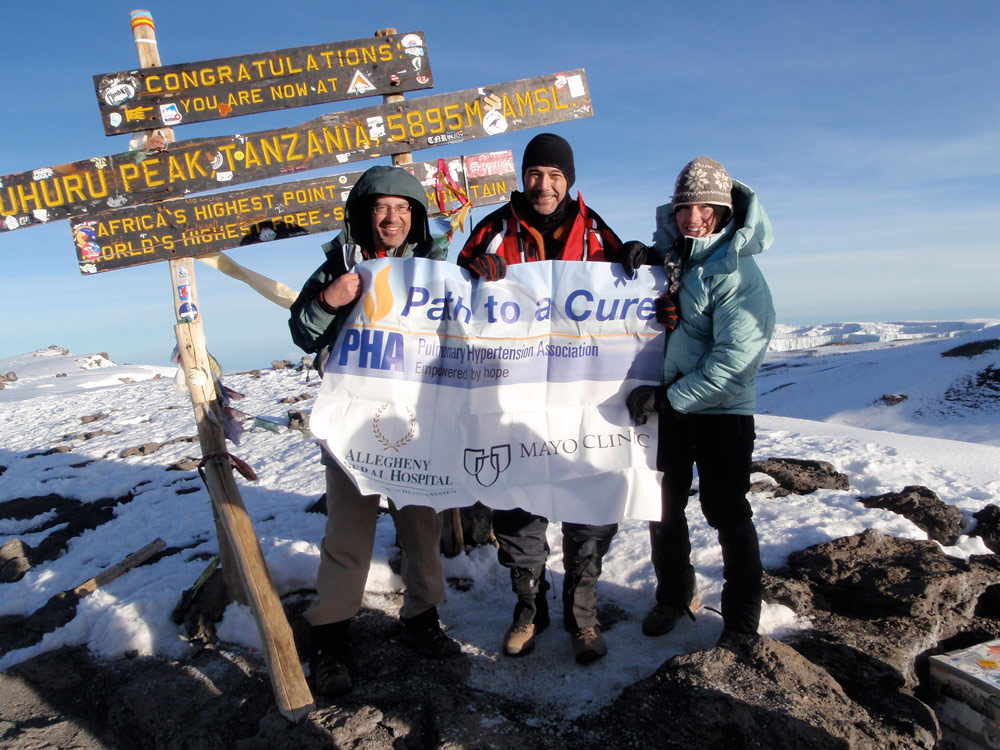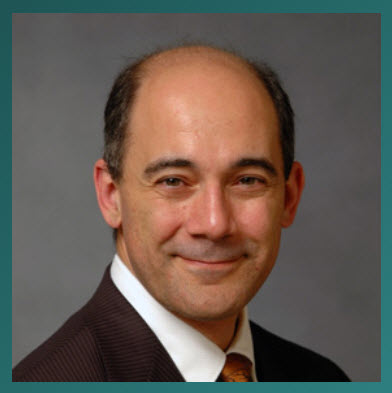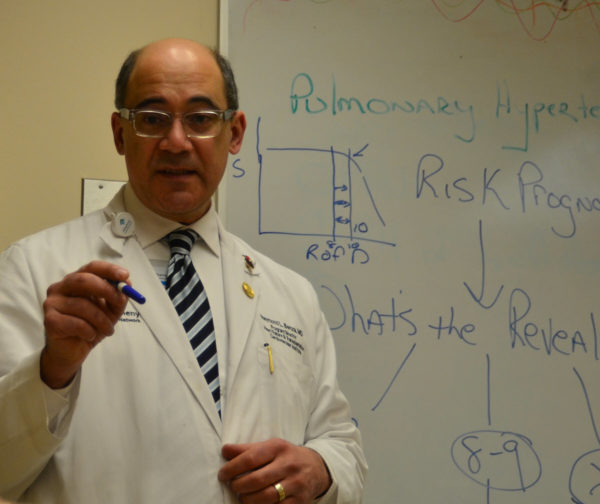In our Ask a Doc series, we sit down with physicians and other clinical experts, including those at Allegheny Health Network (AHN), for a chat on an important health topic. In this edition, we discuss pulmonary hypertension with Dr. Raymond Benza.
Pulmonary hypertension is a progressive, life-threatening disease that affects the arteries in the heart and lungs, causing breathlessness, fatigue, chest pain, and, if untreated, eventual organ failure. The World Health Organization defines five types of pulmonary hypertension — and it can be difficult to diagnose. Although there is no cure, treatments have been developed that can help manage the condition.
Such a complex disease requires bold effort to bring about awareness, improve diagnosis and treatment, and hopefully, find a cure. Dr. Raymond Benza — internationally renowned clinician and researcher with the AHN Cardiovascular Institute — has certainly been bold. He and a small team once chose to summit Africa’s tallest peak, Mt. Kilimanjaro, to raise money for pulmonary hypertension research.
With that as a starting point, Dr. Benza generously shared his expertise and insights on pulmonary hypertension — and mountain climbing — in our interview below.
Emily Adamek (EA): What led to your desire to climb Kilimanjaro?
Dr. Raymond Benza (RB): When I was turning 40, a bunch of friends started talking about mountain climbing. Later, I was sitting with a patient of mine, who was dying of pulmonary hypertension. She was listed for transplant but was getting too sick to be a candidate. She saw that I was distraught, and I remember she sat me down and reached out and held my hand — which is quite a difference because it usually goes the other way around.
She said, “Listen, there’s nothing for you to feel guilty about. You have to remember you can’t always move mountains.”
When she said that, everything clicked. I thought, “Well, I can’t move the mountain, but if it will make a difference, I’m going to climb it.”
A group of us first climbed the Grand Tetons. It ended up being much more than I bargained for, but we made it, and did a dedication to my patient at the top. That climb led to the Mt. Kilimanjaro climb years later, where we raised about $150,000 for pulmonary hypertension research.
Another motive behind climbing was to experience breathlessness — to see how my patients felt. When the average person runs, they get breathless, but it goes away instantly when they stop. On the mountain, at very high altitudes, breathlessness never goes away — just as it doesn’t go away for someone with pulmonary hypertension. It’s a terrible feeling, not being able to catch your breath. That experience made me appreciate what my patients deal with and made me even more determined to come back and do what I could for them.
On a major climb, you also see how, when someone struggles, the group masses around them. Coming back to your patients, you recognize that same phenomenon when care is coordinated the way it should be. Climbing helped me appreciate that and participate with a new kind of understanding.

Dr. Benza (center), with Dr. Robert Franz from the Mayo Clinic (left) and Jessica Lazaar, a physician’s assistant, at the peak of Mt. Kilimanjaro.
EA: Is pulmonary hypertension an uncommon disease?
RB: There are several “flavors” of this disease. One — pulmonary arterial hypertension (PAH) — is rare. In PAH, arteries, lungs, and cells are damaged by a genetic defect, or in relation to another disease state. This happens primarily in young women.

Dr. Ray Benza, internationally renowned clinician and research scientist in heart failure, cardiac transplantation, mechanical circulatory support, and pulmonary hypertension at the AHN Cardiovascular Institute.
Other categories of pulmonary hypertension are more common than most people think — they’re often found with heart failure. The largest is pulmonary hypertension alongside left heart disease. Around 40 to 50 percent of people with heart failure have pulmonary hypertension, which makes their disease course more significant and abrupt. In congestive heart failure, blood moves backward into the lungs, and those arteries serve as a reservoir, but because they weren’t designed to hold fluid, damage occurs.
Another category of pulmonary hypertension is due to lung disease, such as chronic obstructive pulmonary disease (COPD). In this category, the lungs become incapable of getting oxygen from the air into the bloodstream, and the blood vessels respond by getting chronically smaller.
Pulmonary hypertension can also be related to clots that detach and form masses in the lungs. For most people, a clot will be dissolved by the body, but for between 1 and 9 percent of people, it won’t. Because the body can’t clear the clot, it grows, plugging the artery permanently. This is referred to as chronic thromboembolic pulmonary hypertension (CTEPH).
EA: What are the most common symptoms of pulmonary hypertension?
RB: Early symptoms can be vague, which is why pulmonary hypertension is often misdiagnosed or diagnosis is delayed. Shortness of breath, fatigue — a million things can cause those symptoms. If I was a community physician and you came to my office with shortness of breath, my first thought might be asthma, not a life-threatening disease. That’s why we’ve spent a lot of time educating community physicians about the disease and how it can masquerade as more common ailments.
As pulmonary hypertension progresses, people often develop heart failure. This will manifest in symptoms like swelling in the ankles, swelling in the belly, loss of appetite, and they may start passing out when they exert themselves, even with activities as simple as climbing steps or doing laundry.
EA: So it can really impact a person’s lifestyle.
RB: At first, most people feel they’re just out of shape. They either push themselves and develop more significant symptoms, or they stop doing activity altogether, which causes the disease to progress more insidiously.
So yes, pulmonary hypertension alters lifestyle quite a bit. When a person is diagnosed, there are a number of limitations. They can only eat certain foods, they need to be careful with physical activity, and they have to come see us in the clinic a lot. They can’t go to high altitudes — they can’t climb mountains. They have to be cautious about planes because, even in the cabin, ambient oxygen levels are not the same as on the ground.
Patients with pulmonary hypertension also can’t get pregnant, because that can be a particularly deadly combination. We’ve had a couple pulmonary hypertension pregnancies in our practice, and it’s really harrowing. Sometimes a woman is diagnosed and it’s a young couple who wants to have kids, but you have to counsel them to avoid pregnancy, because it could endanger her and the child.
EA: How well are you able to treat pulmonary hypertension once it’s been diagnosed?
RB: Treatment has been revolutionized in the last 10 years. We went from having one drug to having 12 to 18 medications that are FDA-approved, including orals, inhale therapies and subcutaneous therapies. We’re learning how to use these drugs in combination to get the best effect. We’ve improved life expectancy but we haven’t cured the disease.
I mentioned CTEPH earlier. Years ago, a few brilliant people at the University of California San Diego designed a surgical technique called pulmonary thromboendarterectomy to remove the masses caused by CTEPH to restore blood flow. Early on, it was only done in one center in the U.S., and it still is performed at relatively few places. We’re currently the only center in western Pennsylvania that offers this life-saving therapy. Bob Moraca, our cardiovascular and thoracic surgeon, does a fantastic job, and our success rates are extremely good. We’ve attracted people from Indiana, Ohio, West Virginia, Virginia, Maryland, New York, even Montana, and we’ve also received patients from Johns Hopkins.
EA: Can you talk about your two research projects supported by the National Institutes of Health (NIH)?
RB: I just finished a large project with the NIH where we were pioneering the use of an in-dwelling hemodynamic monitor, which is a microchip I can implant in a person’s pulmonary artery. This is technology that has been approved for patients with heart failure, so we took that and applied it to people with pulmonary hypertension.
Typically, we have to do invasive tests on pulmonary hypertension patients. This technology allows us to monitor people at home. Based on information I glean from the monitor, I know whether someone is headed in the right direction or not. It’s like having a virtual touchpoint with that person every day, and it could save lives by predicting when something adverse may occur. The idea has been well-received and the company who manufactures the device, Abbott Medical, is planning a large phase three trial based on our data.
The second project is based on one of my main interests — risk prediction. We’re developing a calculator that can very accurately predict death or clinical worsening events. We can use that data to modify therapy in an attempt to prevent those events. We brought together a group of people from Carnegie Mellon and the University of Pittsburgh to develop an artificial intelligence system based on machine learning and statistical input.
We were able to convince the major pulmonary hypertension drug manufacturing companies to work together and loan us their data from clinical trials so our algorithm can learn. Additionally, the FDA became very interested and is now working with us so that drugs can be used and tested more appropriately in a clinical setting.

Dr. Benza emphasizes the importance of education and awareness on pulmonary hypertension, which is often misdiagnosed because early symptoms resemble more common conditions like asthma.
EA: Earlier you mentioned the importance of educating physicians about pulmonary hypertension. What does that look like?
RB: It can take various forms — we do lectures throughout the U.S. for community physicians, pulmonologists, and cardiologists. It’s been an important part of evolving diagnosis and treatment of pulmonary hypertension — educating people on the risk factors so they can have them in the back of their mind and monitor someone closely if they have a family history.
It’s educating the general public, too. There are two great community educational groups I can recommend. First, the Pulmonary Hypertension Association, whose board of directors I was on, has resources for patients, families and clinicians. Then there’s a newer group called Team PHenomenal Hope, whose board I’m on now. It’s a group of physicians like myself who like to do crazy athletic things to raise money and awareness.
EA: How did pulmonary hypertension become a specialty of yours?
RB: I was doing heart failure transplant work at a time when there were no treatments for patients with pulmonary arterial hypertension. We were seeing people because transplant was their only option. Many were young women, and I thought it was a travesty. It just wasn’t acceptable. With lung transplant, on average, the patient will live seven years after transplant — so that might get the young woman to 30 years old. That’s not a full life.
That’s how I got the clinical research bug. I have questions, and it’s very frustrating waiting for an answer. It’s much better trying to find it yourself. How do we treat this? That question led me to become very interested in this disease-state and I decided to do a sub-specialization in treating those patients as part of my medical training.
EA: So, in a way, you were driven by questioning the world as it was?
RB: I’ve learned many lessons in this career. One is that there are no absolutes in medicine — you constantly have to question. When you stop questioning, you stop growing. We’ve made tremendous strides with pulmonary hypertension. We’ve increased life expectancy three-fold. People who would have had 2.8 years after diagnosis are now living seven to eight more years. You can get them another 10 years with a transplant. That’s amazing, but it’s not perfect. We’re not done yet, and that’s why we have to keep questioning.